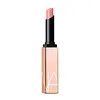What's inside
What's inside
 Key Ingredients
Key Ingredients

 Benefits
Benefits

 Concerns
Concerns

 Ingredients Side-by-side
Ingredients Side-by-side

Tridecyl Trimellitate
EmollientHydrogenated Polyisobutene
EmollientPhenylpropyldimethylsiloxysilicate
EmollientSynthetic Wax
AbrasiveMica
Cosmetic ColorantRicinus Communis Seed Oil
MaskingHydrogenated Vegetable Oil
EmollientPolyethylene
AbrasiveDiisostearyl Malate
EmollientDiglyceryl Sebacate/Isopalmitate
EmollientDimethicone
EmollientDicalcium Phosphate
AbrasivePhytosteryl/Isostearyl/Cetyl/Stearyl/Behenyl Dimer Dilinoleate
Skin ConditioningGardenia Taitensis Flower Extract
Skin ConditioningMoringa Oleifera Seed Extract
Skin ConditioningPolyhydroxystearic Acid
EmulsifyingIsopropyl Myristate
EmollientIsostearic Acid
CleansingEthylhexyl Palmitate
EmollientLecithin
EmollientPolyglyceryl-3 Polyricinoleate
EmulsifyingTriethoxycaprylylsilane
Polysilicone-11
Butyrospermum Parkii Butter
Skin ConditioningEthylene/Propylene Copolymer
AbrasivePentaerythrityl Tetra-Di-T-Butyl Hydroxyhydrocinnamate
AntioxidantTocopherol
AntioxidantWater
Skin ConditioningCollagen
MoisturisingLeuconostoc/Radish Root Ferment Filtrate
AntimicrobialHydrogenated Coco-Glycerides
EmollientSodium Hyaluronate
HumectantHydrogenated Castor Oil
EmollientTocopheryl Acetate
AntioxidantCocos Nucifera Oil
MaskingSimmondsia Chinensis Seed Oil
EmollientMangifera Indica Seed Butter
Skin ConditioningOlea Europaea Fruit Oil
MaskingCaprylyl Glycol
EmollientGlyceryl Caprylate
EmollientGlycerin
HumectantIron Oxides
CI 15850
Cosmetic ColorantCI 77891
Cosmetic ColorantCI 19140
Cosmetic ColorantTridecyl Trimellitate, Hydrogenated Polyisobutene, Phenylpropyldimethylsiloxysilicate, Synthetic Wax, Mica, Ricinus Communis Seed Oil, Hydrogenated Vegetable Oil, Polyethylene, Diisostearyl Malate, Diglyceryl Sebacate/Isopalmitate, Dimethicone, Dicalcium Phosphate, Phytosteryl/Isostearyl/Cetyl/Stearyl/Behenyl Dimer Dilinoleate, Gardenia Taitensis Flower Extract, Moringa Oleifera Seed Extract, Polyhydroxystearic Acid, Isopropyl Myristate, Isostearic Acid, Ethylhexyl Palmitate, Lecithin, Polyglyceryl-3 Polyricinoleate, Triethoxycaprylylsilane, Polysilicone-11, Butyrospermum Parkii Butter, Ethylene/Propylene Copolymer, Pentaerythrityl Tetra-Di-T-Butyl Hydroxyhydrocinnamate, Tocopherol, Water, Collagen, Leuconostoc/Radish Root Ferment Filtrate, Hydrogenated Coco-Glycerides, Sodium Hyaluronate, Hydrogenated Castor Oil, Tocopheryl Acetate, Cocos Nucifera Oil, Simmondsia Chinensis Seed Oil, Mangifera Indica Seed Butter, Olea Europaea Fruit Oil, Caprylyl Glycol, Glyceryl Caprylate, Glycerin, Iron Oxides, CI 15850, CI 77891, CI 19140
Polyisobutene
Hydrogenated Polyisobutene
EmollientPentaerythrityl Tetraisostearate
EmollientParaffinum Liquidum
EmollientDiisostearyl Malate
EmollientPolyglyceryl-3 Diisostearate
EmulsifyingRosa Canina Fruit Oil
EmollientRubus Chamaemorus Seed Oil
Skin ConditioningRubus Idaeus Seed Oil
EmollientSqualane
EmollientAroma
Caprylic/Capric Triglyceride
MaskingDibutyl Ethylhexanoyl Glutamide
Skin ConditioningEthylhexylglycerin
Skin ConditioningTocopherol
AntioxidantTocopheryl Acetate
AntioxidantDiethylhexyl Syringylidenemalonate
Skin ProtectingSorbic Acid
PreservativePhenoxyethanol
PreservativeBenzyl Alcohol
PerfumingPolyisobutene, Hydrogenated Polyisobutene, Pentaerythrityl Tetraisostearate, Paraffinum Liquidum, Diisostearyl Malate, Polyglyceryl-3 Diisostearate, Rosa Canina Fruit Oil, Rubus Chamaemorus Seed Oil, Rubus Idaeus Seed Oil, Squalane, Aroma, Caprylic/Capric Triglyceride, Dibutyl Ethylhexanoyl Glutamide, Ethylhexylglycerin, Tocopherol, Tocopheryl Acetate, Diethylhexyl Syringylidenemalonate, Sorbic Acid, Phenoxyethanol, Benzyl Alcohol
 Reviews
Reviews

Ingredients Explained
These ingredients are found in both products.
Ingredients higher up in an ingredient list are typically present in a larger amount.
Diisostearyl Malate is an emollient and most often used in lip products. It comes from isostearyl alcohol, a fatty acid, and malic acid, an AHA.
As an emollient, Diisostearyl Malate helps create a thin film on your skin to trap moisture in. This helps keep your skin soft and smooth.
Hydrogenated Polyisobutene is a synthetic polymer. Polymers are compounds with high molecular weight. Hydrogenated Polyisobutene is an emollient and texture enhancer.
In one study, Hydrogenated Polyisobutene showed better skin hydration levels than Caprylic/Capric Triglyceride. As an emollient, it helps keep your skin soft and hydrated by trapping moisture in.
Hydrogenated Polyisobutene is often used as a mineral oil replacement.
Learn more about Hydrogenated PolyisobuteneTocopherol (also known as Vitamin E) is a common antioxidant used to help protect the skin from free-radicals and strengthen the skin barrier. It's also fat soluble - this means our skin is great at absorbing it.
Vitamin E also helps keep your natural skin lipids healthy. Your lipid skin barrier naturally consists of lipids, ceramides, and fatty acids. Vitamin E offers extra protection for your skin’s lipid barrier, keeping your skin healthy and nourished.
Another benefit is a bit of UV protection. Vitamin E helps reduce the damage caused by UVB rays. (It should not replace your sunscreen). Combining it with Vitamin C can decrease sunburned cells and hyperpigmentation after UV exposure.
You might have noticed Vitamin E + C often paired together. This is because it is great at stabilizing Vitamin C. Using the two together helps increase the effectiveness of both ingredients.
There are often claims that Vitamin E can reduce/prevent scarring, but these claims haven't been confirmed by scientific research.
Learn more about TocopherolTocopheryl Acetate is AKA Vitamin E. It is an antioxidant and protects your skin from free radicals. Free radicals damage the skin by breaking down collagen.
One study found using Tocopheryl Acetate with Vitamin C decreased the number of sunburned cells.
Tocopheryl Acetate is commonly found in both skincare and dietary supplements.
Learn more about Tocopheryl Acetate